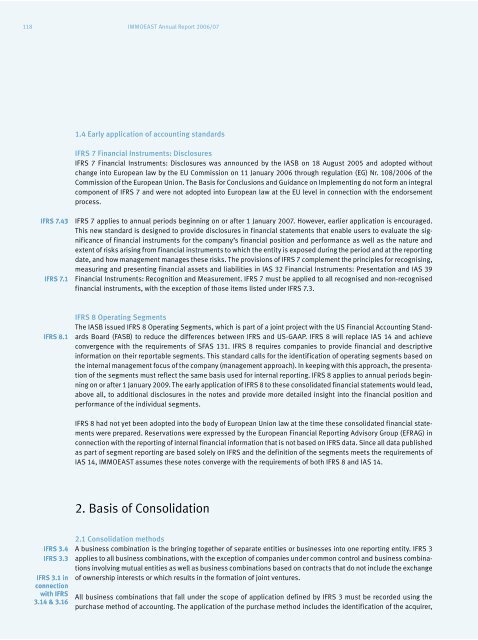IMMOEAST Annual Report 2006/07
IMMOEAST Annual Report 2006/07
IMMOEAST Annual Report 2006/07
You also want an ePaper? Increase the reach of your titles
YUMPU automatically turns print PDFs into web optimized ePapers that Google loves.
118 <strong>IMMOEAST</strong> <strong>Annual</strong> <strong>Report</strong> <strong>2006</strong>/<strong>07</strong><br />
IFRS 7.43<br />
IFRS 7.1<br />
IFRS 8.1<br />
IFRS 3.4<br />
IFRS 3.3<br />
IFRS 3.1 in<br />
connection<br />
with IFRS<br />
3.14 & 3.16<br />
1.4 Early application of accounting standards<br />
IFRS 7 Financial Instruments: Disclosures<br />
IFRS 7 Financial Instruments: Disclosures was announced by the IASB on 18 August 2005 and adopted without<br />
change into European law by the EU Commission on 11 January <strong>2006</strong> through regulation (EG) Nr. 108/<strong>2006</strong> of the<br />
Commission of the European Union. The Basis for Conclusions and Guidance on Implementing do not form an integral<br />
component of IFRS 7 and were not adopted into European law at the EU level in connection with the endorsement<br />
process.<br />
IFRS 7 applies to annual periods beginning on or after 1 January 20<strong>07</strong>. However, earlier application is encouraged.<br />
This new standard is designed to provide disclosures in financial statements that enable users to evaluate the significance<br />
of financial instruments for the company’s financial position and performance as well as the nature and<br />
extent of risks arising from financial instruments to which the entity is exposed during the period and at the reporting<br />
date, and how management manages these risks. The provisions of IFRS 7 complement the principles for recognising,<br />
measuring and presenting financial assets and liabilities in IAS 32 Financial Instruments: Presentation and IAS 39<br />
Financial Instruments: Recognition and Measurement. IFRS 7 must be applied to all recognised and non-recognised<br />
financial instruments, with the exception of those items listed under IFRS 7.3.<br />
IFRS 8 Operating Segments<br />
The IASB issued IFRS 8 Operating Segments, which is part of a joint project with the US Financial Accounting Standards<br />
Board (FASB) to reduce the differences between IFRS and US-GAAP. IFRS 8 will replace IAS 14 and achieve<br />
convergence with the requirements of SFAS 131. IFRS 8 requires companies to provide financial and descriptive<br />
information on their reportable segments. This standard calls for the identification of operating segments based on<br />
the internal management focus of the company (management approach). In keeping with this approach, the presentation<br />
of the segments must reflect the same basis used for internal reporting. IFRS 8 applies to annual periods beginning<br />
on or after 1 January 2009. The early application of IFRS 8 to these consolidated financial statements would lead,<br />
above all, to additional disclosures in the notes and provide more detailed insight into the financial position and<br />
performance of the individual segments.<br />
IFRS 8 had not yet been adopted into the body of European Union law at the time these consolidated financial statements<br />
were prepared. Reservations were expressed by the European Financial <strong>Report</strong>ing Advisory Group (EFRAG) in<br />
connection with the reporting of internal financial information that is not based on IFRS data. Since all data published<br />
as part of segment reporting are based solely on IFRS and the definition of the segments meets the requirements of<br />
IAS 14, <strong>IMMOEAST</strong> assumes these notes converge with the requirements of both IFRS 8 and IAS 14.<br />
2. Basis of Consolidation<br />
2.1 Consolidation methods<br />
A business combination is the bringing together of separate entities or businesses into one reporting entity. IFRS 3<br />
applies to all business combinations, with the exception of companies under common control and business combinations<br />
involving mutual entities as well as business combinations based on contracts that do not include the exchange<br />
of ownership interests or which results in the formation of joint ventures.<br />
All business combinations that fall under the scope of application defined by IFRS 3 must be recorded using the<br />
purchase method of accounting. The application of the purchase method includes the identification of the acquirer,


